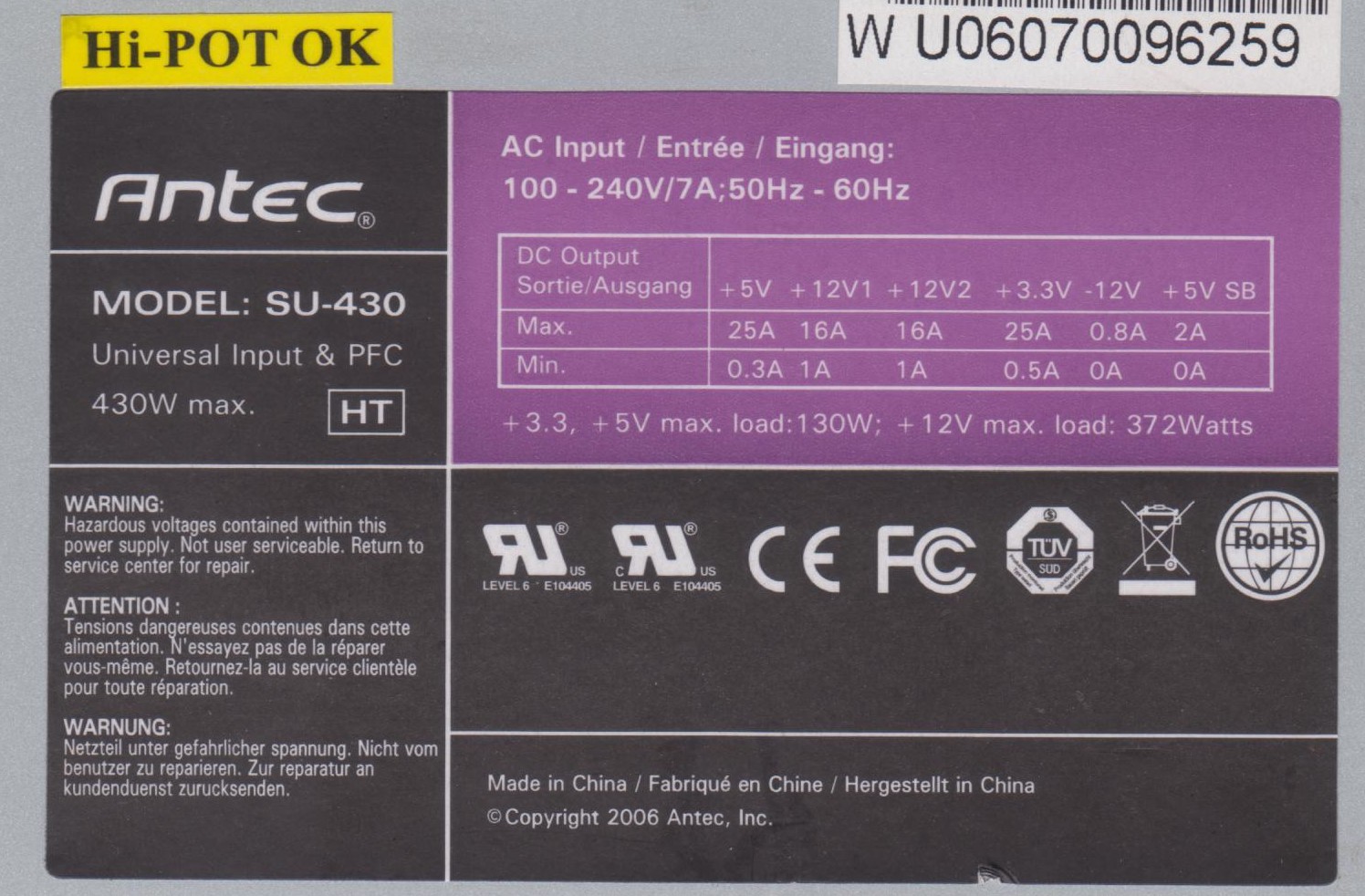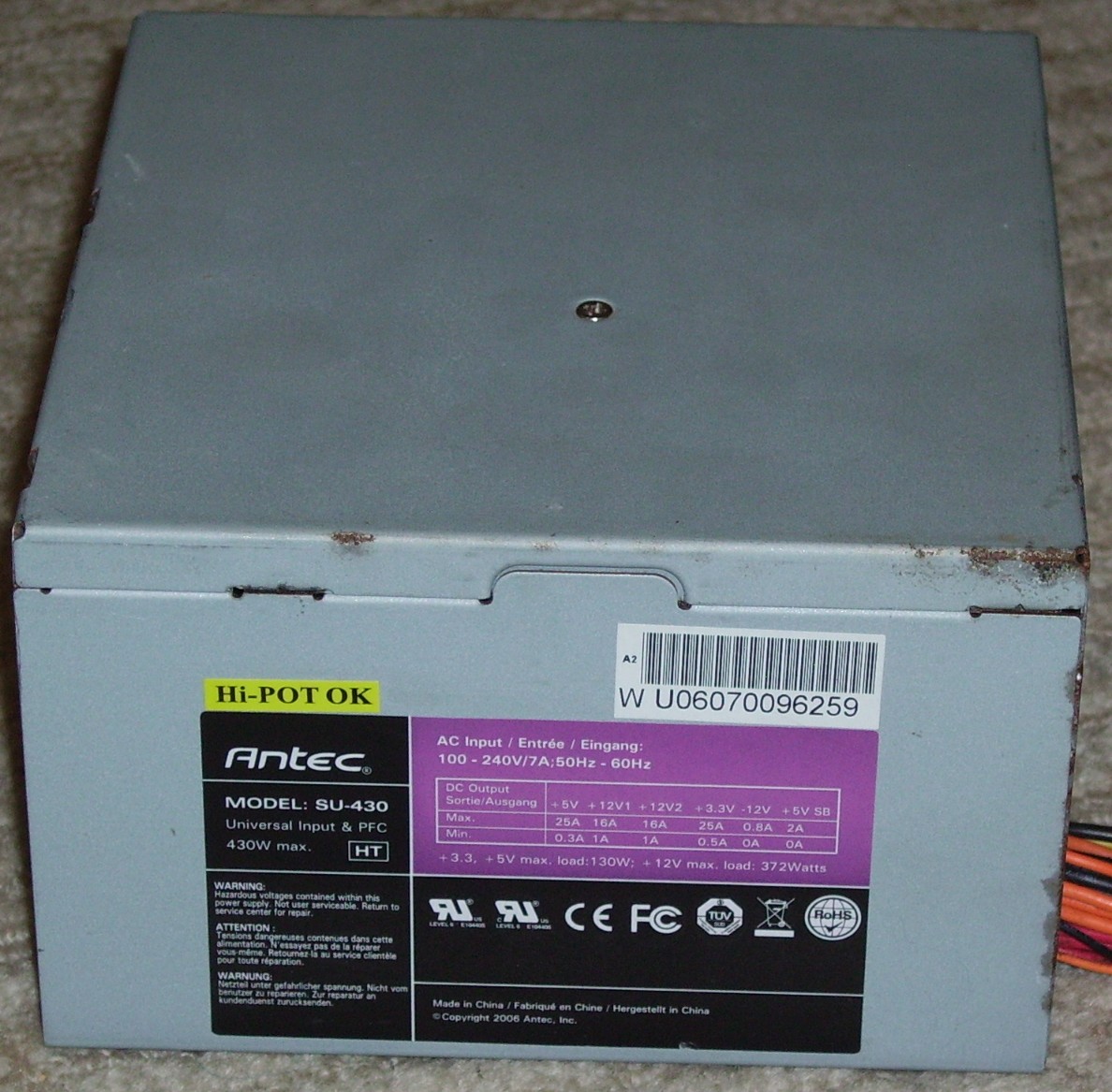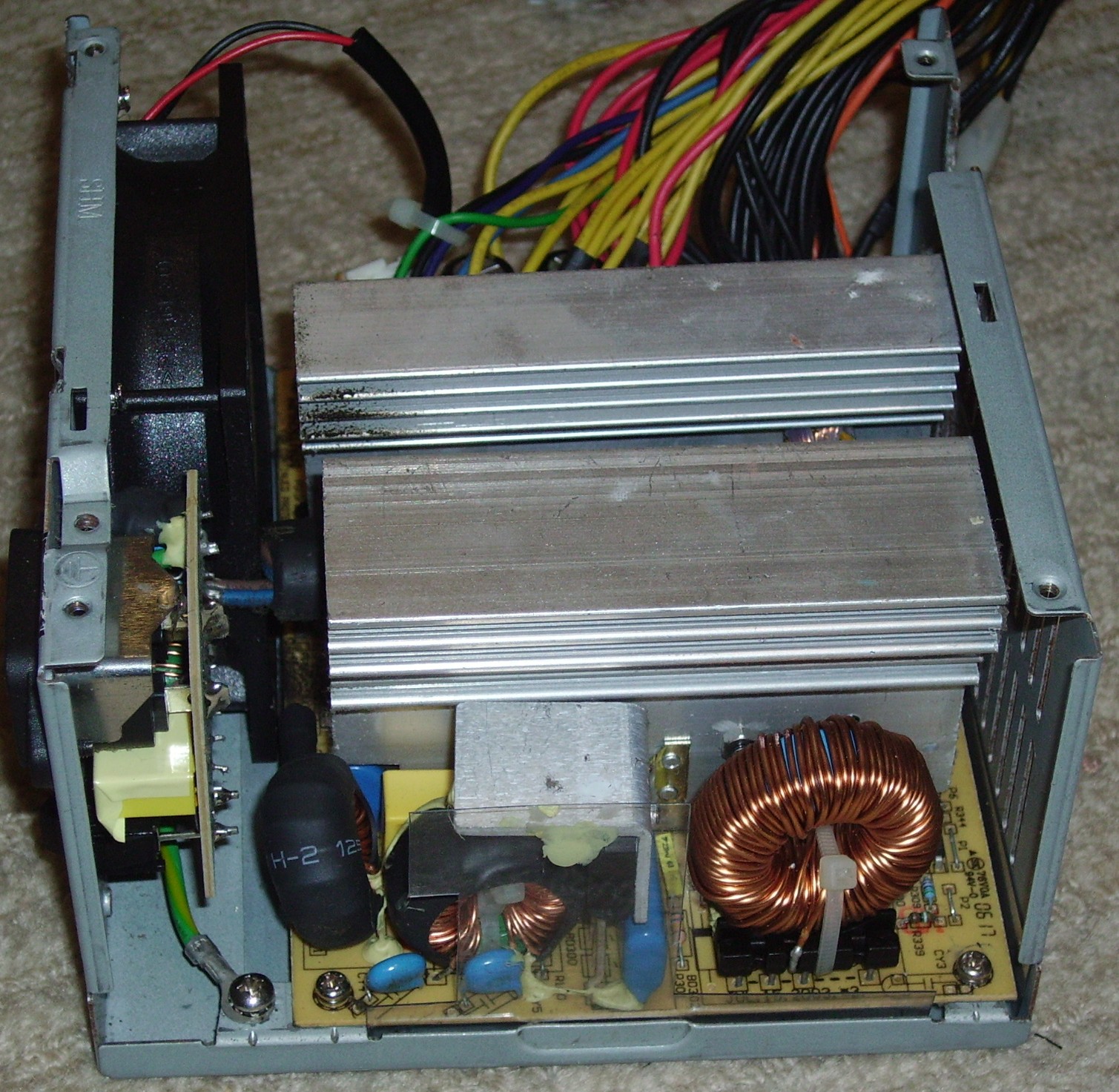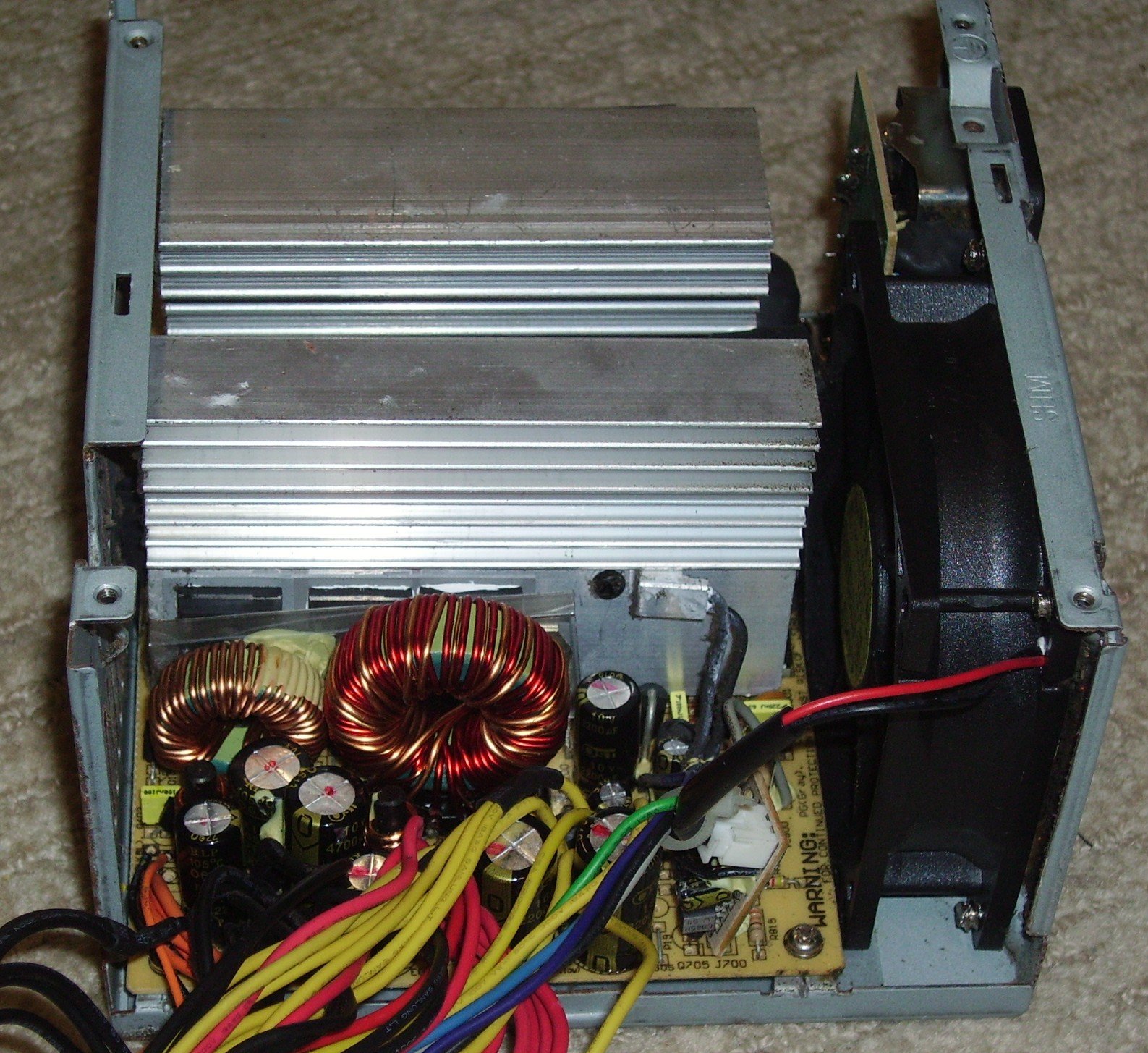First Look
Many people consider Antec to be one of the best brands of power supplies, and with good reason. They do offer some excellent units, such as their Signature and High Current Pro and Gamer series, but today we’re going to find out how one their budget models stacks up. That model is none other than the SU-430. The SU series are only available as bundled units with cases, so you won’t find one at your local computer shop, nor will you find them on Antec’s website.
It looks like we’re dealing with a dual 12v rail unit with active PFC, so the power factor should be fairly close to 1. The UL number (E104405) tells us that the unit is built by Seasonic, so I’m expecting it to be a reasonable unit, both in terms of performance and build quality.
Load Testing
Test 1 (117.73W Load – Cold)
| Rail | Load | Voltage | Ripple |
| 12v1 | 2.41A | 12.03v | 67.2mV |
| 12v2 | 2.40A | 11.99v | 67.2mV |
| 5v | 5.0A | 5.0v | 15.6mV |
| 3.3v | 10.3A | 3.4v | 28.1mV |
| −12v | 0A | −12.04v | 65.6mV |
| 5vsb | 0A | 4.97v | 12.5mV |
| AC Power | 143.3W | ||
| Efficiency | 82.15% | ||
| Power Factor | 0.98 | ||
Test 2 (205.86W Load – Cold)
| Rail | Load | Voltage | Ripple |
| 12v1 | 4.82A | 12.05v | 93.8mV |
| 12v2 | 4.79A | 11.97v | 70.3mV |
| 5v | 9.94A | 4.97v | 25.0mV |
| 3.3v | 10.24A | 3.38v | 20.3mV |
| −12v | 0.1A | −12.04v | 60.9mV |
| 5vsb | 0.98A | 4.91v | 28.1mV |
| AC Power | 277.9W | ||
| Efficiency | 73.97%% | ||
| Power Factor | 0.97 | ||
Test 3 (261.62W Load – Cold)
| Rail | Load | Voltage | Ripple |
| 12v1 | 7.21A | 12.01v | 117mV |
| 12v2 | 7.13A | 11.89v | 107mV |
| 5v | 9.96A | 4.98v | 34.4mV |
| 3.3v | 10.24A | 3.38v | 23.4mV |
| −12v | 0.1A | −12.14v | 65.6mV |
| 5vsb | 0.98A | 4.90v | 32.8mV |
| AC Power | 345.4W | ||
| Efficiency | 76.18% | ||
| Power Factor | 0.98 | ||
Test 4 (315.54W load – Cold)
| Rail | Load | Voltage | Ripple |
| 12v1 | 9.54A | 11.92v | 115mV |
| 12v2 | 9.44A | 11.8v | 109mV |
| 5v | 9.98A | 4.99v | 26.6mV |
| 3.3v | 10.24A | 3.38v | 28.1mV |
| −12v | 0.1A | −12.26v | 64.1mV |
| 5vsb | 0.98A | 4.9v | 57.8mV |
| AC Power | 414.2W | ||
| Efficiency | 76.18% | ||
| Power Factor | 0.99 | ||
Test 5 (366.01W Load – Cold)
| Rail | Load | Voltage | Ripple |
| 12v1 | 11.92A | 11.92v | 126mV |
| 12v2 | 9.47A | 11.84v | 104mV |
| 5v | 14.43A | 4.81v | 26.6mV |
| 3.3v | 10.48A | 3.46v | 31.3mV |
| −12v | 0.1A | −12.43v | 70.3mV |
| 5vsb | 0.98A | 4.9v | 35.9mV |
| AC Power | 486.6 | ||
| Efficiency | 75.22% | ||
| Power Factor | 0.98 | ||
Test 6 (421.74W Load – Hot)
| Rail | Load | Voltage | Ripple |
| 12v1 | 11.92A | 11.92v | 137mV |
| 12v2 | 11.8A | 11.80v | 135mV |
| 5v | 14.4A | 4.80v | 46.9mV |
| 3.3v | 19.88A | 3.28v | 45.3mV |
| −12v | 0.1A | −12.52v | 81.3mV |
| 5vsb | 0.98A | 4.89v | 85.9mV |
| AC Power | 568.5W | ||
| Efficiency | 74.18% | ||
| Power Factor | 0.97 | ||
The good news is that the voltage regulation was OK. It did its job of keeping everything in spec quite nicely. The 3.3v rail was a little high in test 5 (although not quite out of spec), but that was because it didn’t have enough load on it. It went back down when the load was increased for the next test, which brings us to the bad news. The sea in this Seasonic is quite rough with lots of ripples. On the 5vsb rail it went through the roof when I increased the load for Test 6. It jumped from 35.9mV on the previous test all the way up to 85.9mV. That’s an increase of 50mV. Needless to say, that’s way too high, since 50mV is the maximum amount of ripple allowed in ATX specifications for that rail. The ripple on the 12v rails was a bit too high as well. We attempted to increase the load further for an overload test, but the voltages then plummeted way below the minimums allowed in ATX specifications, indicating that the unit was being pushed beyond its limits. Even though it did deliver close to 430W, I can’t call this a 430W unit given how high the ripple was, so I’ll call this one a 350W.
| Rail | Test 5 (366.01W) | Test 6 (421.74W) |
| 12v1 |  |
 |
| 12v2 |  |
 |
| 3.3v |  |
 |
| 5v |  |
 |
| −12v |  |
 |
| 5vsb |  |
 |
| Rail | Test 5 (366.01W) | Test 6 (421.74W) |
| 12v1 | ||
| 12v2 | ||
| 3.3v | ||
| 5v | ||
| -12v | ||
| 5vsb |
| Rail | Test 5 (366.01W) | Test 6 (421.74W) |
| 12v1 | ||
| 12v2 | ||
| 3.3v | ||
| 5v | ||
| -12v | ||
| 5vsb |
A Look Inside
Starting as usual at the input filter, there is a common-mode choke, an X-cap and 2 Y-caps attached to a PCB on the AC inlet. The AC wires also pass through a ferrite core. The main PCB adds a differential-mode choke, another common-mode choke, an X-cap, 2 Y-caps and an MOV, bringing the total number of components to 1 differential-mode choke, 2 common-mode chokes, 2 X-caps, 4 Y-caps and an MOV, which is more than good enough. The unit uses an 8A bridge rectifier, which means it can pull up to 880W from a 110V power grid or 1920W from a 240V grid. Assuming 75% efficiency (which is about what it achieved in most of the tests), this means it can deliver up to 660W and 1440W from a 110V and 240V power grid respectively. For a 430W unit, this is more than adequate. The two PFC transistors are IRFP460As from International Rectifier, rated at 20A at 25°C and 13A at 100°C, with an on resistance of 0.27Ω. The PFC diode is also from International Rectifier, an 8A 8ETH06. For the switching transistor, the unit uses a Fairchild FQA10N80 MOSFET in a single transistor forward configuration. It is rated at 10A at 25°C and 6.32A at 100°C, with an on resistance of 1.1Ω. The PFC Capacitor is a 470μF part made by Hitachi.
Moving on to the secondary, the unit uses S40SC4S rectifiers for all of the rails. I couldn’t for the life of me identify the manufacturer or find a datasheet, but the 40 in S40SC4S suggests that they are probably rated for 40A. There is 1 on the 12v Rail, 2 on the 5v rail and 1 on the 3.3v rail. This means that the unit is actually 5v-heavy, meaning that it would be better suited to an older PC which uses the 5v rail for the CPU. A closer look at the secondary reveals that there is only 1 group of 12v wires, so this isn’t really a dual rail unit like the label says and… hold the phone… the PI filter coil for the 12v rail is missing! And there is just a jumper wire in its place! Now this explains all those ripples in the tests which made this unit such a rough sea sonic. The coil would have improved the ripple suppression somewhat, had it been there. The other thing that is a bit of a let down is the capacitors. All of them are OST.
The fan is an ADDA AD0812HS-A70GL rated at 38.6CFM at 3100RPM with a noise level of 34.4dB at maximum speed. It remained fairly quiet at low loads, but was audible during Test 6 at 420W. Personally, I don’t think fan noise is a real problem if it only happens at higher loads. Note the missing coil in the above right picture.
Specifications
| Real Wattage | 350W |
| OEM | Seasonic |
| PFC | Active |
| Price | Not available for purchase – only comes bundled with cases |
| ATX Connector type | 20+4 pin |
| CPU Connector | ATX12V (4 pin) |
| PCI-E Connectors | 1x 6 pin |
| Molex (Peripheral) Connectors | 6 |
| FDD Power connectors | 1 |
| SATA Power connectors | 2 |
Conclusions
Pros: Active PFC, quiet, good voltage regulation, silicon components more than adequate, input filtering
Cons: Low quality capacitors, poor ripple suppression/missing PI coil
Bottom Line: If one of these comes with your case, then by all means use it, but bear in mind that it shouldn’t be loaded to it’s labelled rating.
Score: 6/10
Discuss this review in our forums here!
Review sample source: Removed from PC








